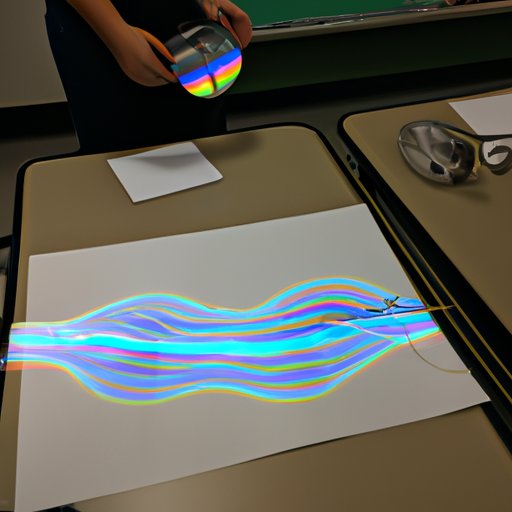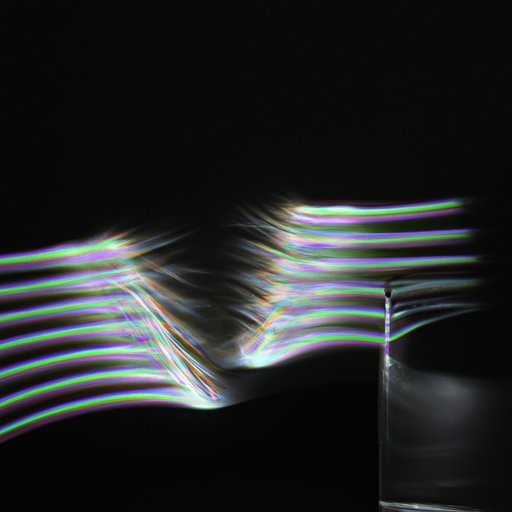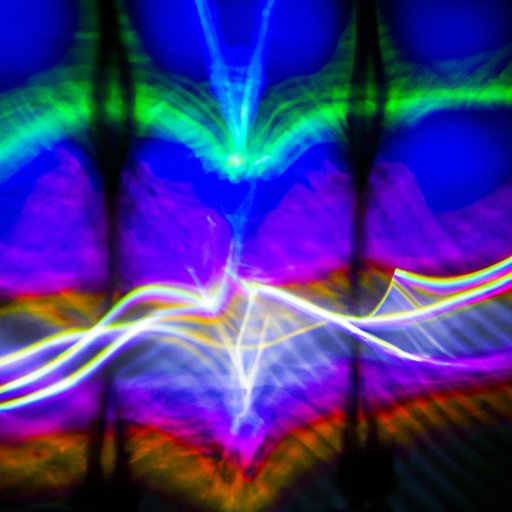Introduction
Light is an electromagnetic radiation, which consists of energy in the form of oscillating waves. These light waves travel through space at a speed of 300,000 kilometers per second, making them the fastest phenomenon known to humans. This article will explore how light waves travel and the physical properties that affect this process.
Explaining the Physics of Light Waves
To understand how light waves travel, it is important to first understand the physics behind them. A wave is a disturbance that propagates through space or matter and is characterized by its frequency, wavelength, and amplitude. The frequency of a wave is the number of times it oscillates per unit of time, while the wavelength is the distance between two successive peaks of the wave. The amplitude is the maximum displacement from the equilibrium position of the wave.
The electromagnetic spectrum is the range of frequencies of electromagnetic radiation, which includes everything from radio waves to gamma rays. All of these waves travel at the same speed, but their difference in frequency causes them to have distinct properties. Light waves are a type of electromagnetic radiation that falls within the visible spectrum, meaning they can be detected by the human eye.
Light waves are generated when an electric field couples with a magnetic field. This coupling of fields creates an energy that radiates outward as a wave. When the electric field changes direction, the wave oscillates in the opposite direction, creating a ripple effect.
Examining the Properties of Light Waves
Light waves have many properties that make them unique. They are transverse waves, meaning they vibrate perpendicular to the direction of propagation. They also have a dual nature; they can behave like particles called photons, or they can act like waves. Additionally, they can travel through a vacuum, which is why they can reach us from distant stars.
Different types of light waves have different properties. Visible light, for example, is composed of all the colors of the rainbow and has a wavelength that ranges from 400 nanometers (violet) to 700 nanometers (red). Infrared and ultraviolet light have longer wavelengths than visible light, while X-rays and gamma rays have shorter wavelengths.
Light waves also have different properties depending on the medium they are traveling through. In a vacuum, light travels in a straight line, but in other mediums, such as air, water, or glass, it can be bent or reflected. This is due to the fact that light waves interact with the atoms and molecules of the medium, causing them to be refracted or reflected.

Investigating How Light Waves Travel Through Different Mediums
Understanding how light waves travel through different mediums requires knowledge of the concept of refraction. Refraction occurs when a wave passes from one medium to another and its velocity changes. This causes the wave to bend, as seen when a stick is placed in a pool of water and appears to be bent at the surface. This effect occurs because the velocity of light is slower in water than in air.
Refraction also affects the wavelength of light waves. When light passes from one medium to another, its wavelength changes, causing it to be dispersed into its component colors. This is why a rainbow appears in the sky after a rainstorm; the sunlight is refracted by the water droplets in the atmosphere, dispersing the light into its component colors.
Light waves also interact with other substances, such as mirrors and lenses. Mirrors reflect light, while lenses can focus light into a beam. This is due to the fact that light waves can be manipulated through the use of curved surfaces. By changing the shape of the surface, the angle of the incident light can be changed, allowing it to be focused or reflected in a specific direction.
Comparing Different Types of Light Waves
Visible light is the only type of light we can see with our eyes, but there are other types of light waves that are invisible to us. Infrared and ultraviolet light have longer and shorter wavelengths than visible light, respectively. X-rays and gamma rays have even shorter wavelengths and higher frequencies, making them dangerous to humans if exposed for too long.
The properties of these different types of light waves vary greatly. Visible light is the only type of light that can be seen by the human eye, but infrared and ultraviolet light can be detected by certain instruments. X-rays and gamma rays have so much energy that they can penetrate through solid objects, making them useful for medical imaging.

Analyzing the Effects of Refraction on Light Waves
Refraction has a significant effect on the behavior of light waves. When a wave passes from one medium to another, its velocity changes and it becomes refracted. This causes the wave to bend and its wavelength to change, resulting in the dispersion of white light into its component colors. This phenomenon is used in optics to create lenses, telescopes, and microscopes.
Refraction can also be used to manipulate light waves in other ways. Prisms, for example, are devices made up of two or more triangular surfaces that are used to split light into its component colors. This effect is used in optical instruments to analyze the composition of light.

Exploring the Impact of Interference on Light Waves
Interference is the phenomenon in which two or more waves combine to form a new wave. When two waves meet, they can either add together (constructive interference) or cancel each other out (destructive interference). This phenomenon can have a significant impact on the behavior of light waves.
Interference can cause light waves to become focused, diffracted, or scattered. Focusing occurs when two waves combine to form a single wave with a larger amplitude. Diffraction happens when a wave bends around an obstacle, while scattering occurs when a wave is scattered in all directions after encountering an obstacle.
Interference can also be used to manipulate light waves. By controlling the phase of the incident light, it is possible to create patterns of constructive and destructive interference that can be used to produce images or enhance optical signals.
Conclusion
In conclusion, this article has explored how light waves travel and the physical properties that affect this process. We discussed the physics of light waves, their properties, how they interact with different mediums, and the effects of refraction and interference. We also compared different types of light waves and investigated how they can be harnessed and manipulated.
By understanding the principles of light waves, we can better understand the world around us and develop new technologies to manipulate and control light. With further research and experimentation, the possibilities are endless.
(Note: Is this article not meeting your expectations? Do you have knowledge or insights to share? Unlock new opportunities and expand your reach by joining our authors team. Click Registration to join us and share your expertise with our readers.)
